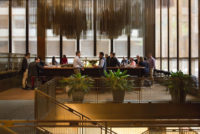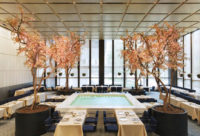If you were an aficionado of the old Four Seasons restaurant—soon to reopen elsewhere but formerly in the Seagram Building in New York— you will see a huge difference in the space, which now houses two restaurants. It begins the moment you enter the white travertine lower lobby on 52nd Street, no longer spare. A host in a Tom Ford tuxedo greets you at a white-lacquered reception desk with an extravagant floral display and inquires which restaurant you have reserved: the Grill (formerly the Grill Room), serving chef Mario Carbone’s chophouse favorites; or the Pool (formerly the Pool Room), where you find chef Rich Torrisi’s seafood cuisine. These new establishments are the result of the building's new owner, New York developer Aby Rosen, with the Major Food Group Company (MFG); Carbone and Torrisi are also partners in the enterprise.
Another host accompanies you as you mount the existing bronze staircase to the restaurants and bar, past Cy Twombly and Franz Kline paintings (on loan from Rosen), stone benches, and ferns.
Then comes the good news: the 60-by-90-foot interior seems little changed from its 1959 Philip Johnson incarnation, though it is brighter and warmer, owing to a new computer-controlled LED lighting system by Hervé Descottes of L’Observatoire International.
In 2015, Rosen hired New York architect Annabelle Selldorf to restore the space, the interiors of which are landmarked. This involved scrubbing 50 years of nicotine from the ceiling, polishing the brass rod sculptures by Richard Lippold above the bar and balcony, repairing Marie Nichols’s swagged aluminum beaded curtains, and cleaning the French burl walnut walls.
Then Rosen asked New York architect William T. Georgis to decorate the two restaurants. He had a clean slate, because former proprietors Julian Niccolini and Alex von Bidder sold the (non-landmarked and removable) furnishings and accoutrements at a wildly successful auction last summer, where a group of four ashtrays with the logo sold for $10,000.
Nonetheless, the Grill looks very familiar—on purpose. “We wanted to keep as much as you possibly could,” Georgis says. He had Knoll reproduce Mies van der Rohe’s 1930 Brno dining chairs and bar stools, although he designed the banquettes with higher backs. In the private dining room behind the balcony, new custom furniture complements two large Lee Krasner paintings, set off by the repainted perforated metal of Philip Johnson’s “Starry Night” ceiling. Throughout these areas, a brown, red, and olive carpet, based on a Van Day Truex pattern from the 1950s, replaces the previous grayish-green one.
But the rest of Rosen’s domain does not stay as true to its former self. In the hall linking the Grill to the Pool, where Picasso’s 1919 theater curtain Le Tricorne once hung, Rosen commissioned a formidable lacquered-steel wall sculpture with plants by the artist Paula Hayes. (A glass-walled wine cellar is still there, now filled with bottles of vintage Chateau d’Yquem.)
Yet most surprising—and sad—is the Pool dining room: there are no trees to change from summer to fall to winter to spring! The white marble fountain still occupies the center of the space, but a sizable Calder mobile is suspended over it. “We felt we needed some large element to mitigate the scale,” says Georgis. “We’re not about four seasons anymore.” The Calder is a fine sculpture but a poor substitute for the trees, which (though fake) dramatized the soaring space.
Georgis eliminated the private dining room on the mezzanine in the rear to create the Pool Lounge, which recalls a Deco-era nightclub. It has taped music (soon to be live) and its own bar, but uses the Pool entrance. Separating the mezzanine from the Pool are five floor-toceiling doors that, Georgis says, “will always be open.” Mirrors on the back wall of the lounge reflect light, along with a Tara Chapas handwoven navy wall covering shot with silver thread “to look like moonlight on water,” Georgis says. Artist Nancy Lorenz conceived of the bar, sheathed in shimmering mother-of-pearl tiles, while Georgis designed the carpet, gray with navy-and-white ink splatterings. It’s all very glam, yet the feeling is young and casual.
Rosen and MFG have invested $30 million so far. (The investment includes the Lobster Club restaurant in the adjacent former Brasserie space, a Peter Marino project slated to open in October.) But the real test of success may come in early 2018, when Niccolini and Von Bidder’s new Four Seasons, designed by Brazilian architect Isay Weinfeld, will reopen just a few blocks away.












Post a comment to this article
Report Abusive Comment